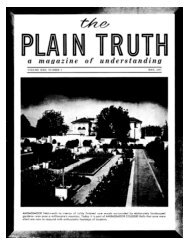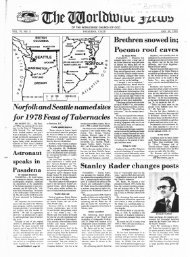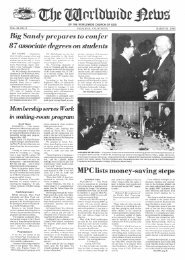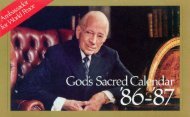The Biblical Basis of the Sacred Calendar Part One
The Biblical Basis of the Sacred Calendar Part One
The Biblical Basis of the Sacred Calendar Part One
Create successful ePaper yourself
Turn your PDF publications into a flip-book with our unique Google optimized e-Paper software.
conjunction [molad] may precede or be preceded by <strong>the</strong> true conjunction. <strong>The</strong> absolute maximum<br />
interval between <strong>the</strong>m, arising from <strong>the</strong> combined effect <strong>of</strong> <strong>the</strong> maximum quotas <strong>of</strong> <strong>the</strong> solar and<br />
lunar anomaly is approximately 14 hours. In Tishri ... approximately 14 hours is <strong>the</strong> maximum<br />
interval from <strong>the</strong> true conjunction to <strong>the</strong> mean conjunction, whereas <strong>the</strong> maximum interval from <strong>the</strong><br />
mean conjunction to <strong>the</strong> true conjunction will not exceed six to seven hours; in Nisan ...<br />
approximately 14 hours is <strong>the</strong> maximum interval from <strong>the</strong> mean conjunction to <strong>the</strong> true conjunction<br />
and only six-seven hours from <strong>the</strong> true conjunction to <strong>the</strong> mean conjunction; with varying seasonal<br />
maximum and minima in <strong>the</strong> o<strong>the</strong>r months <strong>of</strong> <strong>the</strong> year." "<strong>Calendar</strong>", Judaica, col. 45.<br />
13. <strong>The</strong> mean time from <strong>the</strong> true conjunction to <strong>the</strong> full moon is about 14.7 days. Since <strong>the</strong> new<br />
crescent may appear up to three clock days after <strong>the</strong> true conjunction <strong>of</strong> Tishri, does this mean that<br />
<strong>the</strong> 15th calendar day from <strong>the</strong> new crescent could begin after <strong>the</strong> two-clock-day range during which<br />
<strong>the</strong> calendar day <strong>of</strong> <strong>the</strong> full moon occurs (cf. below, main text)? This is worth fur<strong>the</strong>r detailed study.<br />
14. Tishri 1 may also fall "before <strong>the</strong> day <strong>of</strong> <strong>the</strong> phasis [new crescent] begins or, in some extremely<br />
rare cases, on <strong>the</strong> day immediately after <strong>the</strong> phasis (never later), with a ra<strong>the</strong>r wider range <strong>of</strong> <strong>the</strong><br />
occurrence <strong>of</strong> <strong>the</strong> New Moon before and after <strong>the</strong> day <strong>of</strong> <strong>the</strong> phasis in o<strong>the</strong>r months; such oscillation<br />
is inherent in a system, like <strong>the</strong> present Jewish calendar, based on mean values." "<strong>Calendar</strong>",<br />
Judaica, col. 46.<br />
15. <strong>The</strong> musical accentuation confirms that <strong>the</strong> order <strong>of</strong> <strong>the</strong> months in <strong>the</strong> calendar was changed at<br />
this time -- yet only for <strong>the</strong> sacred year, as <strong>the</strong> Bible, secular history and Jewish sources such as<br />
Josephus all confirm that <strong>the</strong> civil year continued to be reckoned fall-to-fall.<br />
16. "<strong>The</strong> persecutions under Constantinus [<strong>the</strong> Roman Emperor Constantine] finally decided <strong>the</strong><br />
patriarch, Hillel II, (330-365), to publish rules for <strong>the</strong> computation <strong>of</strong> <strong>the</strong> calendar, which had hi<strong>the</strong>rto<br />
been regarded as a secret science….This unselfish promulgation <strong>of</strong> <strong>the</strong> calendar, though it<br />
destroyed <strong>the</strong> hold <strong>of</strong> <strong>the</strong> patriarchs on <strong>the</strong> scattered Judeans, fixed <strong>the</strong> celebration <strong>of</strong> <strong>the</strong> Jewish<br />
feasts upon <strong>the</strong> same day everywhere. Later Jewish writers agree that <strong>the</strong> calendar was fixed by<br />
Hillel II, in <strong>the</strong> year…359 C.E. Some, however, as Isaac Israeli, have fixed <strong>the</strong> date as late as 500.<br />
SAADIA afterward formulated calendar rules [in <strong>the</strong> tenth century C.E./A.D]…" ("<strong>Calendar</strong>", Jewish<br />
Encyclopedia, p. 500a). <strong>The</strong> Encyclopedia Judaica concurs: "By <strong>the</strong> tenth century <strong>the</strong> Jewish<br />
calendar was exactly <strong>the</strong> same as today" ("<strong>Calendar</strong>", p. 50b).<br />
17. Even in <strong>the</strong> rabbinc calendar, <strong>the</strong> "secret <strong>of</strong> intercalation" was this: "Whenever it becomes<br />
apparent that <strong>the</strong> winter will last till <strong>the</strong> 16th <strong>of</strong> Nisan [as it would normally be reckoned by <strong>the</strong><br />
rabbinic calendar], make that year a leap-year [sic] without hesitation." This "secret" was "revealed"<br />
by Rabbi Huna ben Abin to Raba in Babylonia (cf. "<strong>Calendar</strong>", Jewish Encyclopedia, p. 500b).<br />
18. Cf. <strong>The</strong> New Brown-Driver-Briggs-Genesius Hebrew-Aramaic Lexicon, p. 423a.<br />
19. Cf. <strong>the</strong> o<strong>the</strong>r three places in <strong>the</strong> Bible where tequfah is used (1 Samuel 1:20; 2 Chronicles 24:23;<br />
Psalm 19:6). In all cases, tequfah refers to a period, not a single moment or day, <strong>of</strong> "turning". (Cf.<br />
<strong>The</strong> New BDBG, p. 880b.)<br />
20. <strong>One</strong> might be confused by <strong>the</strong> usage <strong>of</strong> <strong>the</strong> nouns motsa'o (from <strong>the</strong> verb yatsa') and tequfah in<br />
Psalm 19:6. Yet this verse refers to <strong>the</strong> rising ("exit") <strong>of</strong> <strong>the</strong> sun above <strong>the</strong> horizon and its turning to<br />
<strong>the</strong> place where it sets on <strong>the</strong> opposite horizon. Obviously, <strong>the</strong> latter follows <strong>the</strong> former. Yet <strong>the</strong><br />
"turning <strong>of</strong> <strong>the</strong> year" in Exodus 34:22 does not necessarily follow (in time order) <strong>the</strong> "going out" <strong>of</strong><br />
<strong>the</strong> year in Exodus 23:16, especially since <strong>the</strong> phrase "turning <strong>of</strong> <strong>the</strong> year" does not specify<br />
progression to an end.<br />
21. In <strong>the</strong> rabbinic calendar, tequfah refers to <strong>the</strong> specific date <strong>of</strong> an equinox or a solstice. Thus<br />
rabbinic treatises on our received calendar refer to <strong>the</strong> "four tequfot", which are yet calculated by an<br />
arbitrary division <strong>of</strong> a solar year <strong>of</strong> 365¼ days into four equal parts (Arthur Spier, <strong>The</strong><br />
Comprehensive Hebrew <strong>Calendar</strong>, pp. 19-20).<br />
22. Such a year was 30-31 A.D., <strong>the</strong> year Jesus died on our Gregorian calendar. 1996-1997 was<br />
ano<strong>the</strong>r, recent example.<br />
23. Cf. my article, "Passover, Unleavened Bread and Pentecost: <strong>The</strong> Solution to an Ancient<br />
Conundrum," which deals with this matter and many o<strong>the</strong>rs which have troubled <strong>the</strong> ministry and<br />
membership <strong>of</strong> <strong>the</strong> Churches <strong>of</strong> God.<br />
24. I have made slight adjustments to <strong>the</strong> lengths <strong>of</strong> <strong>the</strong> months (in terms <strong>of</strong> number <strong>of</strong> characters
















